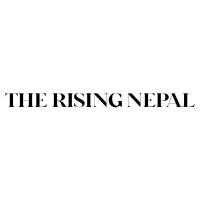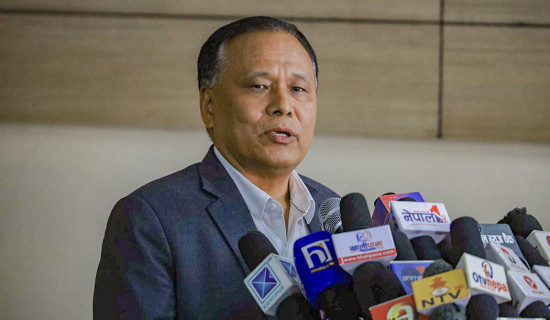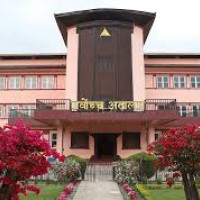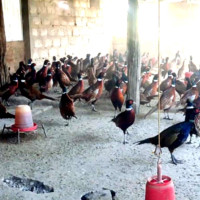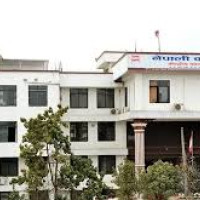- Monday, 29 December 2025
Unique Forms of Lakhe Dance
Year-round religious festivals in Dolakha town begin following the celebration of Gantakarna Parba on Shrawan Krishna Chaturdasi. Among these, one of the first jatras is the Lakhe (demon) dance, which starts from Shrawan Krishna Aunsi. The Lakhe dance is a significant cultural performance observed in Newar settlements nationwide, including Diktel, Okhaldhunga, Bandipur, Kuncha, Bhojpur, and the Kathmandu Valley.
In Newar Bhasha, the word Lakhe refers to a carnivorous monster. Resembling a demon, the Lakhe is adorned with a frightening mask, silver ornaments, and long black hair made from a yak's tail. Colourful handkerchiefs are tied to both arms, and the performer is dressed in a vibrant red costume. The mask, bearing a terrifying Newari-Tibetan aesthetic, reflects the rich cultural fusion of Hinduism and Buddhism inherent in the dance.
There are various legends surrounding the origin of the Lakhe dance. One such account, narrated by the late Bhairav Bahadur Thapa, tells of a king named Lang Dharp in Tibet. It is said a horn had grown on his head, which he concealed by wrapping his hair around it. His reign was marked by violence and bloodshed.
Upon learning of this, Padmasambhava, a revered Buddhist figure, visited the palace in disguise as a magician and dancer. He performed a dance called "Jhungwa," meaning joker or Khyali. The costumes and makeup for this dance were extremely frightening. The sleeves of his outfit were so wide that he concealed a bow and arrow within them.
During the performance, Padmasambhava revealed the bow and shot an arrow into King Lang Dharp's chest, killing him instantly. Since the dance involved wearing a mask resembling Lang Dharp, it became known as the "Lang Dharp" dance in Tibet and Nepal.
Over time, Newar traders who travelled to Tibet called the dance "Laa Khya," meaning meat-eating ghost. Some Newars learnt the dance while living there and, upon returning to Nepal, began performing and teaching it. The dance eventually became widely known as the Lakhe dance, and to this day, it is traditionally performed exclusively by members of the Newar community across Nepal.
While Lakhe dances are performed in many Newar settlements throughout Nepal, the version found in Dolakha holds a unique identity and originality. In this historic town, there are four distinct forms of Lakhe dance. Although the Lakhes wear similar masks and costumes, the dancing styles are entirely different.
Various forms of Lakhe
In Dolakha Bhasha, Jonga Dakas means "hand-held Lakhe." In this form, the Lakhe's hands are held by two other individuals—either ordinary participants or Daure (Khyali) performers wearing masks and distinctive clothing. This Lakhe dance typically starts around 3 p.m. and ends by 5 p.m. With a frightening appearance, the Lakhe chases and occasionally playfully beats the spectators. The audience teases the Lakhe by shouting "Lakhe, Lakhe" and waving money.
Aside from the two who hold the Lakhe's hands, two or three additional performers dressed as Daure or Khyali also dance to entertain the crowd.
On the eve of Hile Jatra, especially on Shrawan Sukla Trayodashi, the town of Dolakha resounds with the sounds of Lakhe music. On this day, Lakhe dances are performed simultaneously from three significant parts of the city—Lower Tole, Upper Tole, and Dungal Tole. Since this festival comes after the completion of paddy and millet planting, locals celebrate with feasting and merriment. This day is considered the climax of the Jonga Dakas, as the performances end after the afternoon's dance.
Historically, Kathmandu was referred to as "Nepal," which suggests that Nepal Dakas originated there. In Kathmandu, the Lakhe dance is performed only during Indra Jatra in the daytime. However, in Dolakha, this Lakhe is performed only at night. Starting from Shrawan Krishna Aunsi, the Jonga Dakas is performed during the day, while Nepal Dakas occurs at night.
The dance style and accompanying music differ significantly from Jonga Dakas. Two or three performers acting as Daure (Khyali) add dramatic and comic elements to entertain the audience. The Lakhe is paraded through the main streets of the town. While most Newar settlements perform this dance during the day, Dolakha uniquely presents it at night.
Nepal Dakas is performed daily during Hile Jatra, concluding on Shrawan Sukla Trayodashi, with a reprise during Indra Jatra.
On the day of Janai Purnima, a special Lakhe called Dawaku Dakas (meaning "large Lakhe") is presented. This Lakhe emerges from the same house every year, with Lower Tole and Upper Tole taking turns dancing annually. After fulfilling the rituals and completing the dance, the Lakhe re-enters the same house, marking the end of the year's Dawaku Dakas. This dance is only performed once a year and is exclusively taken out from Tallo Tole.
The mask and costume of Dawaku Dakas are different from those of ordinary Lakhes. Although it is performed during the day, teasing of the Lakhe or the Lakhe chasing spectators does not occur on this occasion.
Maajipa Lakhe is performed in Dolakha during Gai Jatra and Indra Jatra, whereas in Kathmandu, it is shown only on the last day of Indra Jatra. While the name sounds similar, the legend and performance style in Dolakha differ significantly from those in Kathmandu. In Dolakha, "Maajipa" refers to a kingdom of Majis (fishermen).
According to local cultural expert Tulasi Narayan Joshi, Maajipa was a land of fishermen known as Maazipah. Fishing and selling fish were their main occupations. One day, four fishermen cast their net into the river. A heavy catch required all four to pull it out, but instead of a fish, they found a terrifying monster trapped in their net.
Fearing destruction if the monster were left free, they tied it with ropes and paraded it through the market before presenting it to the king. They pulled the monster in four directions, each holding a rope.
The Maajipa Lakhe dance re-enacts this event, depicting the Lakhe tied with ropes, struggling to escape, while the four fishermen try to control him. The costume differs from other Lakhes—instead of the usual red, the Maajipa Lakhe wears green, likely symbolising the moss and mud from the river. In Dolakha, various unique Lakhe dances enrich the town's cultural identity. However, no formal Guthi (cultural institution) organises or safeguards this tradition. Therefore, to preserve and promote this vibrant and entertaining heritage, establishing a dedicated Guthi is essential.
(Joshi writes on economic and cultural topics.)


